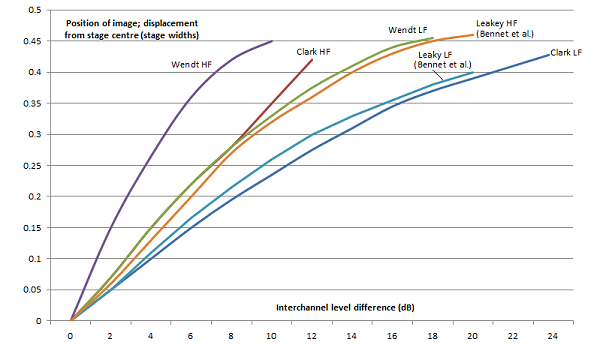


The studies (from a period spanning 30 years) are:
There is admirable consistency between the studies of Clark et al., Leakey and Bennett et al. And each study clearly identified that high-frequencies sounds localise at a different position in the stereo image compared with those at low-frequency for a given interchannel intensity ratio.
Wendt's study appears to give very different results - although the finding of different LF and HF positions is consistent. The reason for these differences is probably that Wendt immobilised the heads of his experimental subjects so they could not turn towards the sounds; a natural reaction. The other experimenters did not include this precaution.
The study by Bennett et al. is interesting because it is much later than the other studies and the performance of a stereophonic sound reproduction system is considered in terms of its wavefront reconstruction capabilities. This is a modern and rather mathematical approach. The authors demonstrate that at low frequencies a two-channel system is capable of generating substantially plane waves in the region of the listener, with a tilt or phase slope determined by the interchannel intensity difference. Such a wavefront is characteristic of a single, distant source emanating from an angular location within the sound stage bounded by the loudspeakers. They substantiate this with experimental data which very closely confirms Leakey's much earlier results. (This parallels the analysis of Clark et al. in terms of phase difference at the ears of the listener at lower frequencies but is formalised in an entirely different way, an approach which derives ultimately from Alan Blumlein.)
The authors then go further to analyse why, at higher frequencies, the stereophonic system can no longer maintain its low-frequency performance as a wavefront reconstruction apparatus, and a reduction of the central image occurs. It is this reduction in the central component which causes images at HF to migrate towards the louder of the two loudspeakers when an interchannel amplitude difference exists between the loudspeakers. In other words, for the HF image to be "wider"than the LF image. Once again, they confirm this analysis with their own listening tests which substantiate Leakey's experimental results from 1959.
 Home page
Home page
For all support issues, go here.
For Pspatial Audio sales, email: sales@pspatialaudio.com
